Why do you get varicose veins

|
Varicose veins are a very common disease in daily life. It not only causes great harm to the patient's physical health, but also seriously affects their normal life and work. Therefore, it is particularly important to understand its cause and do preventive work in advance. The most common causes are femoral saphenous vein valvular insufficiency and primary deep venous valvular insufficiency of the lower extremities. 1. Varicose veins Varicose veins refer to the tortuosity and dilation of veins due to factors such as blood stasis and weak venous walls. Varicose veins can occur in many parts of the body. For example, hemorrhoids are actually a type of varicose veins. Other clinically visible varicose veins include esophageal varicose veins, varicocele, abdominal wall varicose veins, etc. The most common site of varicose veins is the lower extremities. It is worth emphasizing that varicose veins themselves may be a secondary manifestation of other lesions, such as vena cava occlusion, and the primary disease should be actively treated. 2. Why do varicose veins occur? There are many causes of varicose veins in the lower limbs, the most common of which is simple superficial varicose veins in the lower limbs, the main cause of which is the insufficiency of the femoral saphenous vein valve. Another important cause is primary deep venous insufficiency (PDVI) of the lower extremities, which is often combined with great saphenous vein valvular insufficiency and often manifests as tortuous dilatation of the superficial veins. In addition, post-deep vein thrombosis syndrome in the lower limbs causes compensatory tortuous dilatation of the superficial veins due to poor deep vein reflux; lower limb arteriovenous fistula and venous malformation hypertrophy syndrome can also present with varicose veins of the lower limbs; obstruction of inferior vena cava reflux, such as Budd-Chiari syndrome, can also lead to varicose veins of the lower limbs. According to the cause, varicose veins are divided into primary varicose veins and secondary varicose veins. 3. Treatment Methods In addition to wearing elastic stockings, traditional high ligation of the great saphenous vein, varicose vein stripping, laser, radiofrequency, rotary resection, and sclerosing agent refraction, the treatment of varicose veins in the lower limbs also includes some drugs for auxiliary treatment: such as diosmin tablets. In many foreign guidelines for the treatment of chronic venous diseases of the lower limbs, drug treatment is the basis, and pressure therapy with elastic stockings is consolidation. There are many surgical treatment methods, which need to be decided according to the specific situation of the patient. Currently, radiofrequency treatment has also become a new minimally invasive method and will be promoted in China. Sclerotherapy is not suitable for every patient. Although it has obvious advantages, the indications must be strictly controlled. |
>>: Inferior vena varicose vein
Recommend
Treatment of recurrent ovarian cancer
Recurrence has always been a major problem for pa...
Can I eat beans if I have skin cancer?
Beans have anti-cancer effects. Soybeans contain ...
Surgical treatment of colorectal cancer
Colorectal cancer is one of the most common malig...
How to put out alcohol fire?
Alcohol is a common liquid in daily life. Alcohol...
What happens if hair has no follicles? How to deal with it?
The health of hair is an aspect that people pay m...
How much does small cell lung cancer cost
How much does small cell lung cancer cost? In rec...
Celery Freezing Tips
Celery is a very spice-rich ingredient and natura...
What shoes to wear in winter
For many people, winter is a very awkward season....
Is it better to have a rhinoplasty with thread carving or a prosthesis
In modern society, rhinoplasty surgery has been r...
What are the symptoms of colorectal cancer and how to diagnose it?
In addition to early colorectal cancer, which may...
What to do if your bangs are naturally curly?
Girls will spend a lot of time and energy to take...
How to treat bone metastasis of colorectal cancer
I had surgery for colorectal cancer, and every ch...
Can green peppers be eaten raw?
Green pepper is a common food in daily life and c...
Is daylily poisonous?
There are many vegetables in our lives, and these...
Gynecologist explains the causes of teratoma
There are many types of tumors derived from the r...









